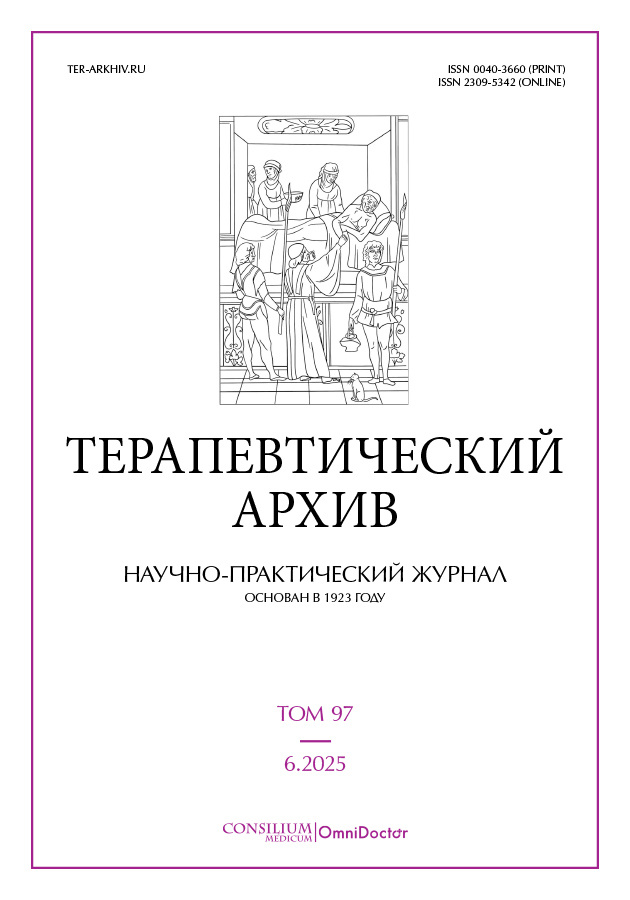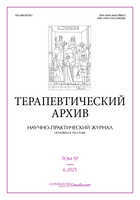Terapevticheskii arkhiv
Monthly peer-review medical journal
Editor-in-Chief
Irina Chazova
MD, PhD, Professor, Academician of the Russian academy of Sciences
ORCID: 0000-0002-1576-4877
About
Therapeutic archive journal (ISSN key title is "Terapevticheskiy arkhiv") was founded by the prominent Russian therapists M.P. Konchalovsky and G.F. Lang in 1923. Then its editors-in-chief were Professors V.N. Vinogradov and A.G. Gukasyan. Since 1972, E.I. Chazov, Academician of the Russian Academy of Sciences, has been heading the editorial board of the journal.
Over 90 years, there have been more than 1000 issues where the authors and editorial staff have done their best for readers to keep abreast of current advances in medical science and practice and for physicians to master the advanced principles of recognition and treatment of a wide spectrum of visceral diseases.
The papers published in the journal (editorials, original articles, lectures, reviews, etc.) cover both current scientific achievements and practical experience in diagnosing, treating, and preventing visceral diseases. The authors of publications are not only Russian, but also foreign scientists and physicians. All papers are peer-reviewed by highly qualified Russian specialists.
The journal is published monthly. Traditionally, each issue has predominantly certain thematic areas covering individual therapy specializations. Every year, one of the issues is devoted to related problems in practical medicine (allergology and immunology, neurology and psychiatry, obstetrics, oncology, etc.). This all draws the attention of the reading public to the journal.
Publications
Monthly issues publish in print and online in Open Access under the Creative Commons NC-ND 4.0 International Licensee.
Indexation
- Web of Science:
- Russian Science Citation Index (RSCI)
- Core Collection (Science Citation Index Expanded)
- PubMed/Medline
- Index Medicus
- Current Contents Connect
- BIOSIS Previews
- Scopus/EMBASE
- Ulrich’s Periodicals Directory
- Google Scholar
Current Issue
Vol 97, No 6 (2025): Issues of nephrology
- Year: 2025
- Published: 12.07.2025
- Articles: 7
- URL: https://ter-arkhiv.ru/0040-3660/issue/view/9299
Full Issue
Editorial
Modern approaches to the chronic glomerulonephritis classification
Abstract
Chronic (CGN) glomerulonephritis (GN) is a heterogeneous group of immune-mediated kidney diseases requiring a clear classification system to optimize diagnosis and therapy. This article reviews the evolution of CGN classification, from clinical and morphological criteria to modern immunopathogenetic frameworks. The importance of categorizing CGN into five major groups (immune complex GN, antineutrophil cytoplasmic antibody (ANCA)-associated GN, anti-glomerular basement membrane disease, monoclonal immunoglobulin-associated GN, and C3-glomerulopathy) based on pathogenesis, activity, and degree of chronicity is emphasized. Advantages of immunophenotyping-based classification, integrating analysis of biopsy samples, serological markers, and genetic data, are presented. Emerging approaches enable personalized treatment, including immunosuppression, clone-oriented therapies, and targeted cytokine/complement blockade. The necessity of integrating molecular-immunological data into clinical practice to enhance diagnostic accuracy and therapeutic efficacy is highlighted. Modern CGN classification systems pave the way for targeted drug use and improved patient outcomes.
 484-488
484-488


Original articles
The importance of detection of autoantibodies to podocytes in primary podocytopathies
Abstract
Primary podocytopathies, minimal change disease (MCD) and focal segmental glomerulosclerosis (FSGS) are diseases with unknown pathogenesis. Currently, it is assumed that the production of autoantibodies to podocyte antigens is the cause of damage to the glomerular barrier and the development of nephrotic syndrome in these kidney diseases.
Aim. To determine the value of detecting antibodies to podocyte nephrin and synaptopodin for the diagnosis of MCD and FSGS.
Materials and methods. The study included 75 patients with nephrotic syndrome: 38 were diagnosed with FSGS, 12 with MCD, and 25 with membranous nephropathy. Samples from 11 healthy individuals were obtained as a control group. The level of antibodies to nephrin and synaptopodin in the blood serum of patients and healthy individuals was determined by enzyme immunoassay.
Results. Serum antibody levels in patients with MCD and FSGS were significantly higher than in patients with membranous nephropathy and in healthy individuals. An increase in antibodies to nephrin compared to healthy individuals was found in 91% of patients with MCD and 69% of patients with FSGS, antibodies to synaptopodin were increased in 92% of patients with MCD and 73% of patients with FSGS, however, no significant difference was found in the average level of these antibodies between the MCD and FSGS groups. According to ROC-analysis, the serum nephrin antibody level over 41.6 ng/ml had a high specificity of 80% but a low sensitivity of 56.1% for diagnosing podocytopathies. Higher values were calculated for synaptopodin antibodies (sensitivity 78.12%, specificity 90.48% for a level of 10.2 ng/ml). Simultaneous assessment of nephrin and synaptopodin antibodies significantly increased the diagnostic accuracy for determining MCD/FSGS: sensitivity was 85.7%, specificity 90.48%, AUC 0.935 (95% CI 0.856–0.984).
Conclusion. The level of nephrin and synaptopodin antibodies increases in patients with MCD and FSGS compared to membranous nephropathy and healthy individuals. Combined assessment of antibodies to nephrin and synaptopodin allows to increase the accuracy of diagnostics of primary podocytopathies.
 489-493
489-493


Factors associated with the outcomes of ANCA-associated glomerulonephritis: a retrospective cohort study
Abstract
Background. Kidney involvement is one of the prognostically significant manifestations of ANCA-associated vasculitis (AAV). The aim of the study was to evaluate factors associated with kidney survival in patients with biopsy proven ANCA-associated glomerulonephritis (ANCA-GN).
Materials and methods. Patients with AAV and biopsy proven pauci-immune extracapillary glomerulonephritis who underwent in-hospital and/or outpatient management between 2014 and 2024. AAV was diagnosed in accordance with the ACR classification criteria (2022) and the Chapel Hill Consensus Conference definitions (2012). The primary end-point was time from kidney biopsy to chronic kidney disease according to the KDIGO 2024 definition. Estimated GFR was calculated using CKD-EPI 2021 equation using serum creatinine concentration. Cox proportional hazards model and binary logistic regression were used to identify factors associated with outcomes.
Results. A total of 91 patients were included in the study, including 56 (62%) women. The median age of AAV onset was 50 (35; 58) years and the median duration of follow-up was 40 (14; 66) months. CKD G5 developed in 21 (23%) patients, 19 of them required kidney replacement therapy. Meanwhile, a total of 70 (77%) patients fell into high and very high risk groups according to the KDIGO CKD classification. Factors associated with adverse kidney outcome that confirmed their statistical significance in multivariate models were ARRS high-risk group and AKRiS very high-risk group, dialysis dependance at the time of biopsy, and initial oral glucocorticoid dose <30 mg/day. Female sex was associated with a lower risk of adverse kidney outcome.
Conclusion. The outcomes of ANCA-GN remain unfavourable. Occurrence of CKD G5 is associated with ARRS and AKRiS risk groups, dialysis dependance at the time of biopsy, and low glucocorticoid dose.
 494-502
494-502


Reviews
Radiomics capabilities in the interpretation of ultrasound and CT data in patients with chronic kidney disease: A review
Abstract
The purpose of this review is to explore the possibilities of radiomics in interpreting ultrasound and multislice spiral computed tomography data in patients with chronic kidney disease (CKD). Radiomics is a promising area of medical image analysis based on the extraction of quantitative features not available in standard visual analysis and the subsequent use of artificial intelligence methods for their processing and interpretation. The article discusses the basics of radiomic methods, including texture analysis of images and the creation of diagnostic models using machine learning algorithms. The advantages of radiomic characteristics, in particular statistical features of order II and higher orders, in assessing interstitial fibrosis and other abnormal changes in the renal parenchyma are discussed in detail. The results of studies demonstrating a strong correlation of radiomic signs with histological changes detected during kidney biopsy are presented. The prospects of radiomics as a non-invasive approach for assessing kidney damage and monitoring CKD progression are emphasized. The conclusion indicates the need for further research to standardize and expand the use of radiomic methods in clinical practice to improve the diagnosis accuracy and prognostic assessment of patients with CKD.
 503-508
503-508


Current prospects of fluoroquinolones: pazufloxacin. A review
Abstract
Fluoroquinolones (FQ) are one of the most valuable groups of antibacterial drugs in clinical practice. Ciprofloxacin and levofloxacin are drugs with the largest contribution to the structure of FQ consumption both in the Russian Federation and in the world. The widespread use of FQ in recent years has been accompanied by an intensive growth of antibiotic resistance of the main pathogens, including those from the ESKAPE group, which limits the possibilities of effective antibiotic therapy for a wide range of infectious diseases. In this situation, we have an attractive possibility of including a new FQ for the Russian pharmaceutical market, pazufloxacin, in the treatment regimens for patients with infectious diseases. This is a third-generation FQ, whose spectrum of antibacterial action, as has been demonstrated in the published studies, is close to that of the beta-lactam ABP ceftazidime. The studies considered in our narrative review indicate a high level of clinical efficacy and safety of this FQ, which suggests broad prospects for its use in the treatment of infectious diseases taking in account accelerated antibiotic resistance.
 509-521
509-521


Clinical notes
A complicated case of cutaneous necrotizing vasculitis associated with monoclonal gammopathy. Case report
Abstract
Diagnosing diseases related to monoclonal gammopathy (MG) with clinical significance is challenging. In real-world practice, proving the connection between organ damage and paraprotein or plasma cell dyscrasia is difficult or even impossible. Only an atypical course of the disease and non-compliance with the established criteria may suggest the contribution of plasma cell neoplasia in pathogenesis. Rheumatic diseases associated with monoclonal secretion do not belong to MG with clinical significance. Therefore, in the absence of hematological malignancy, clone reduction therapy is not indicated. We present the first clinical case of a patient with cutaneous necrotizing vasculitis and MG, who received clone reduction therapy with no hematological malignancy. The rationale for the choice of such treatment approach was the atypical course of vasculitis, as well as the unstable effect after methylprednisolone therapy. Therapy with lenalidomide, cyclophosphamide, and dexamethasone was highly effective; the regression of clinical symptoms was associated with a decrease in paraprotein to trace amounts. However, the lack of evidence of the relationship of vasculitis with plasma cell dyscrasia does not support considering the described case as one of the forms of MG with clinical significance. Further observation and resumption of monoclonal secretion, coinciding with the recurrence of vasculitis, may additionally support the relationship between these two conditions. This case was discussed at the Council of Experts with hematologists, rheumatologists, and pathologists.
 522-527
522-527


History of medicine
Gut microbiota: Historical essay and role in nephrology
Abstract
The article covers the main stages of intestinal microbiota (MB) research from ancient to modern times and addresses the features of the interaction between intestinal MB and renal diseases, the gut-kidney axis. It is believed that for the first time, MB was mentioned in one of the treatises of Ayurveda, “Caraka-Samhitā” (700–100 BC), and the first use of probiotics was mentioned in Ancient China (1000 BC). In the 1670s, Antonie van Leeuwenhoek, using an advanced microscope, described protozoa and bacteria, including intestinal MB. Later, in parallel with the discoveries of Louis Pasteur and Robert Koch, intestinal MB was a subject for research, with studies by Theodor Escherich, Henri Tissier, and our compatriots S.N. Vinogradsky and I.I. Mechnikov playing an important role. The next stage in the study of intestinal MB dates back to 1994 with the beginning of the use of 16s rRNA sequencing, metascience, and the organization of global projects for the MB study, the Human Microbiome Project and METAgenomics of the Human Intestinal Tract, the purpose of which is to study its composition and interaction with the body. An example of such an interaction is the gut-kidney axis, which reflects the metabolic relationship of the kidneys and intestinal MB. Within the context of this axis, the potential therapeutic possibilities of pro-, prebiotics and synbiotics in kidney diseases are investigated. However, despite advances in the field, further research is needed to develop of the most optimal strategy for correcting microbiota disorders, including in chronic kidney diseases.
 528-533
528-533














